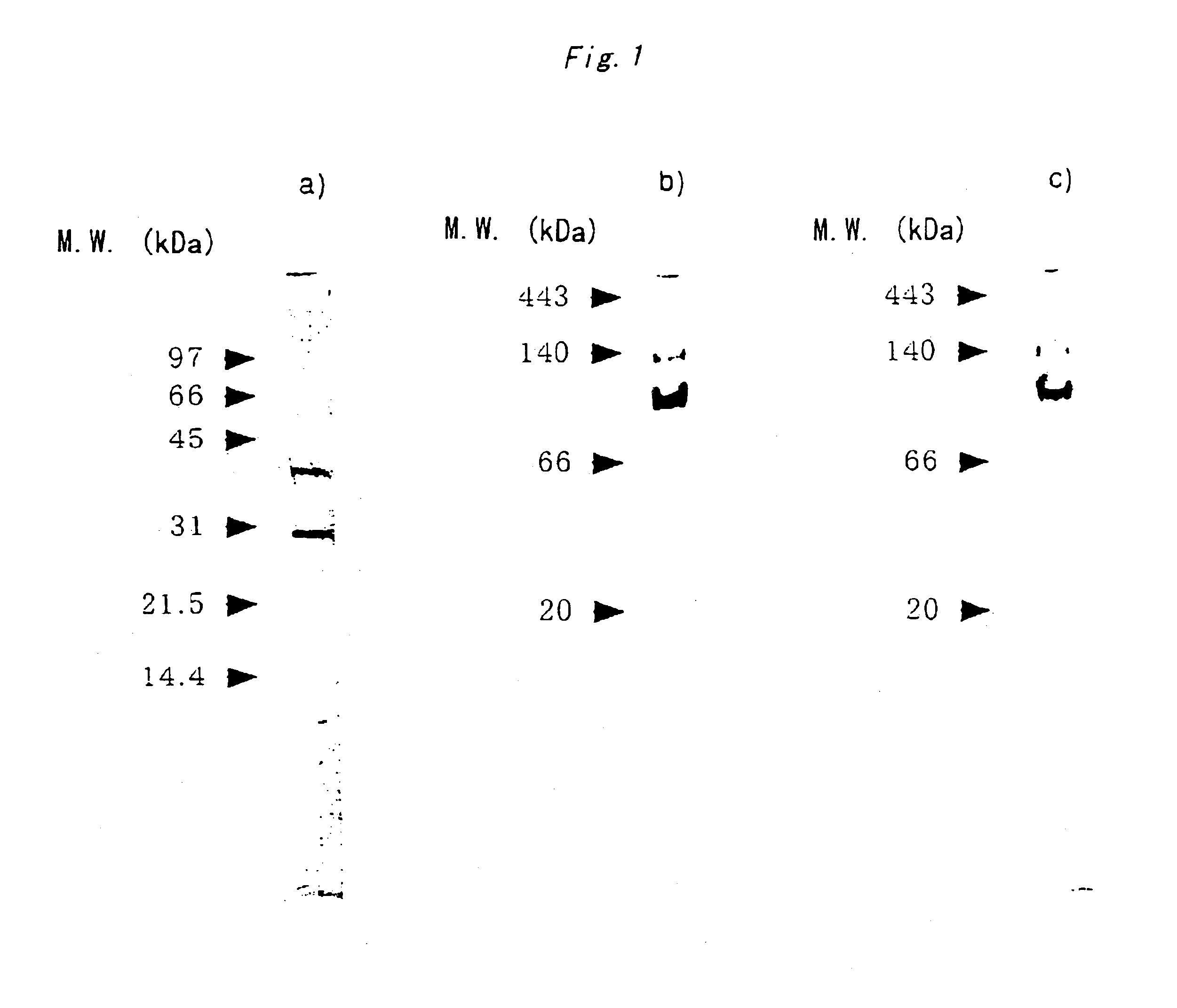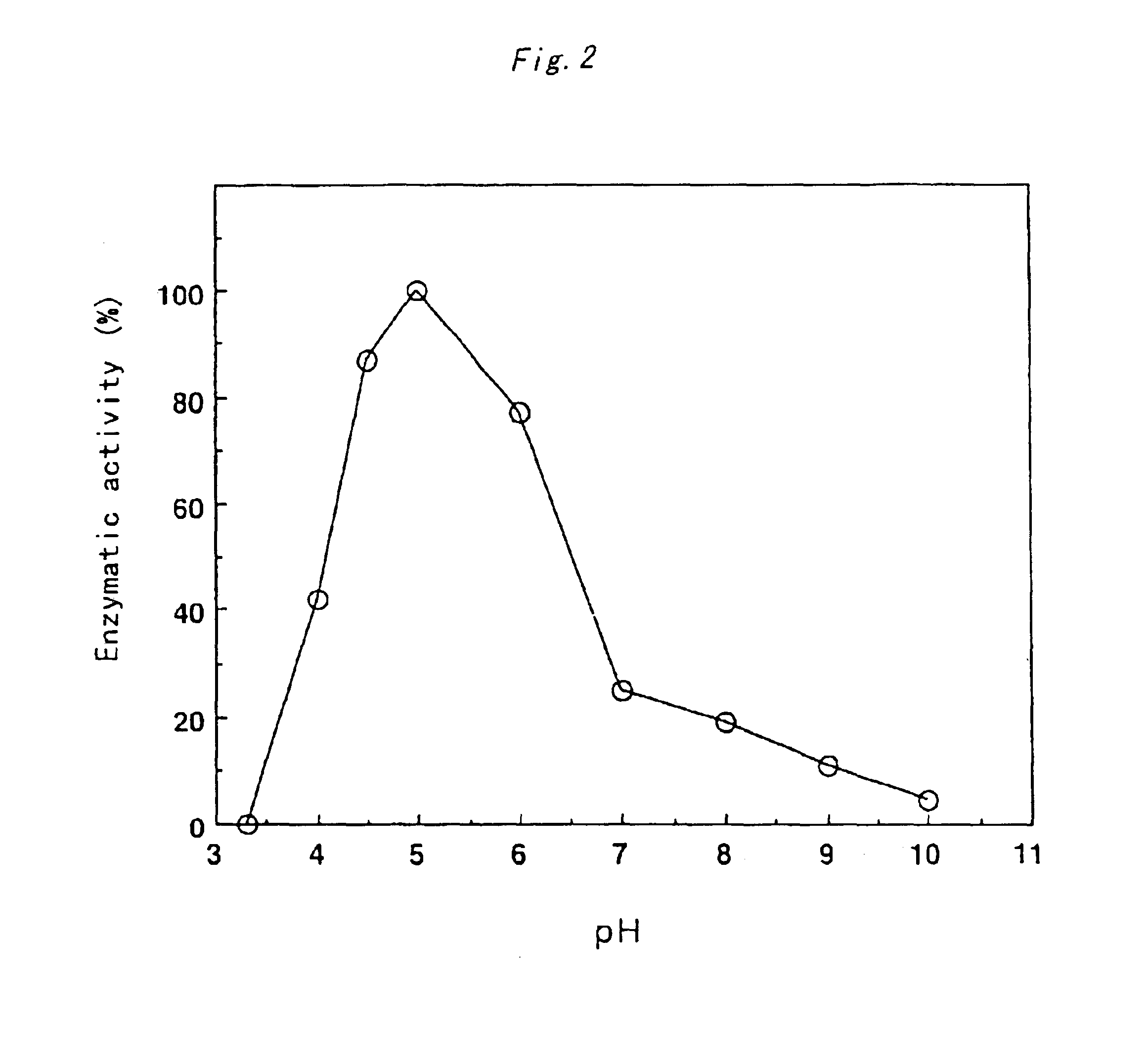Xylitol dehydrogenase of acetic acid bacteria and gene thereof
a technology of acetic acid bacteria and xylitol, which is applied in the field of xylitol dehydrogenase of acetic acid bacteria and the gene thereof, can solve the problems of high production cost, low purity of d-xylitol, and high cost of production, and achieves the effect of reducing production cost, reducing production cost and excellent xylitol production ability
- Summary
- Abstract
- Description
- Claims
- Application Information
AI Technical Summary
Benefits of technology
Problems solved by technology
Method used
Image
Examples
example 1
Production of XDH by Gluconobacter oxydans and Purification Thereof
Culture of Gluconobacter oxydans ATCC621
[0081]The Gluconobacter oxydans strain ATCC621 was cultured to obtain its cells having sufficient XDH activity. The cultivation was always performed in PD medium as broth culture with shaking at 30° C. The PD medium had a composition of 24 g / L potato dextrose (Difco), 30 g / L yeast extract (Difco), 5 g / L meat extract (Difco), 15 g / L glycerol, 10 g / L D-arabitol, 10 g / L D-xylose, 10 g / L xylitol, 20 g / L calcium carbonate (Kanto Chemical), pH 7.0.
[0082]First, as a seed culture, the strain ATCC621 was inoculated into a Sakaguchi flask containing 40 ml of PD medium, and cultured overnight with shaking at 30° C. The obtained culture broth was inoculated in an amount corresponding to 1% into 40 Sakaguchi flasks each similarly containing 40 ml of PD medium, and cultured with shaking for 3 days at 30° C. (main culture). After removing calcium carbonate by centrifugation, the cells were c...
example 2
Conversion of D-xylulose into Xylitol by XDH
[0099]D-Xylulose was converted into xylitol using the purified XDH (XDH1 and XDH2) obtained in Example 1. 0.2 U of the purified XDH was added to 0.25 ml of a reaction solution containing 21 mM D-xylulose, 20 mM NADH, and 100 mM Tris-HCl buffer (pH 8.0), and incubated at 30° C. for 1 hour to allow the reaction. The solution after the reaction was subjected to high performance liquid chromatography (HPLC) to analyze the produced xylitol under the following conditions.[0100]Column: Shodex SC1211 (produced by Showa Denko Co., Ltd.)[0101]Mobile phase: 50% acetonitrile / 50% 50 ppm aqueous Ca-EDTA[0102]Flow rate: 0.8 ml / minute[0103]Temperature: 60° C.[0104]Detection: RI detector
[0105]As a result, formation of 18 mM xylitol was observed in the solution after the reaction, and it was shown that xylitol could be produced from D-xylulose using the purified XDH.
example 3
Isolation of XDH Gene Derived from Gluconobacter
Amplification of XDH Gene Fragment by PCR
[0106](1) Preparation of PCR Primers Based on N-terminus Amino Acid Sequence of XDH
[0107]Based on each of the aforementioned N-terminus amino acid sequences (SEQ ID NOS: 1 and 2) of XDH (XDH1, XDH2) derived from Gluconobacter oxydans ATCC621, mixed primers which had the nucleotide sequences shown as SEQ ID NO: 7-10, respectively, were prepared.[0108](2) Preparation of Chromosome DNA of Gluconobacter oxydans ATCC621
[0109]Gluconobacter oxydans ATCC621 strain was cultured under the following conditions. First, the ATCC621 strain was cultured in 20 ml of YPG medium (3% glucose, 0.5% Bacto yeast extract, 0.3% Bacto peptone, pH 6.5) overnight as a seed culture. By using 5 ml of this culture as seed bacteria, main culture was performed using 100 ml of YPG medium. The culture was performed with shaking at 30° C.
[0110]After the bacteria were cultured to late log phase under the aforementioned condition...
PUM
| Property | Measurement | Unit |
|---|---|---|
| temperature | aaaaa | aaaaa |
| temperature | aaaaa | aaaaa |
| pH | aaaaa | aaaaa |
Abstract
Description
Claims
Application Information
 Login to View More
Login to View More - R&D
- Intellectual Property
- Life Sciences
- Materials
- Tech Scout
- Unparalleled Data Quality
- Higher Quality Content
- 60% Fewer Hallucinations
Browse by: Latest US Patents, China's latest patents, Technical Efficacy Thesaurus, Application Domain, Technology Topic, Popular Technical Reports.
© 2025 PatSnap. All rights reserved.Legal|Privacy policy|Modern Slavery Act Transparency Statement|Sitemap|About US| Contact US: help@patsnap.com


